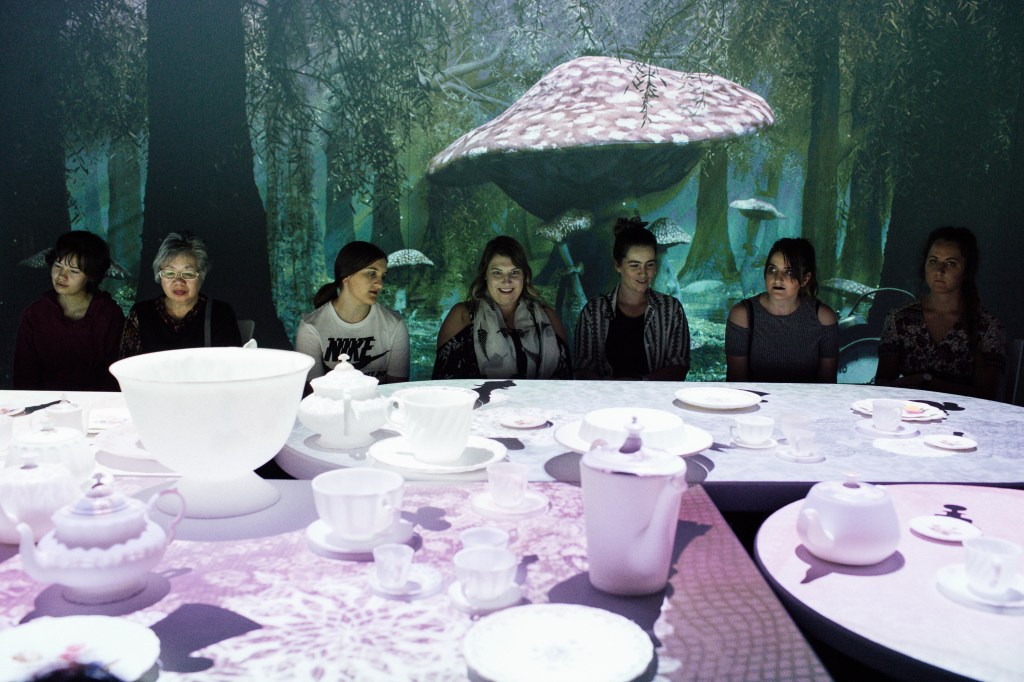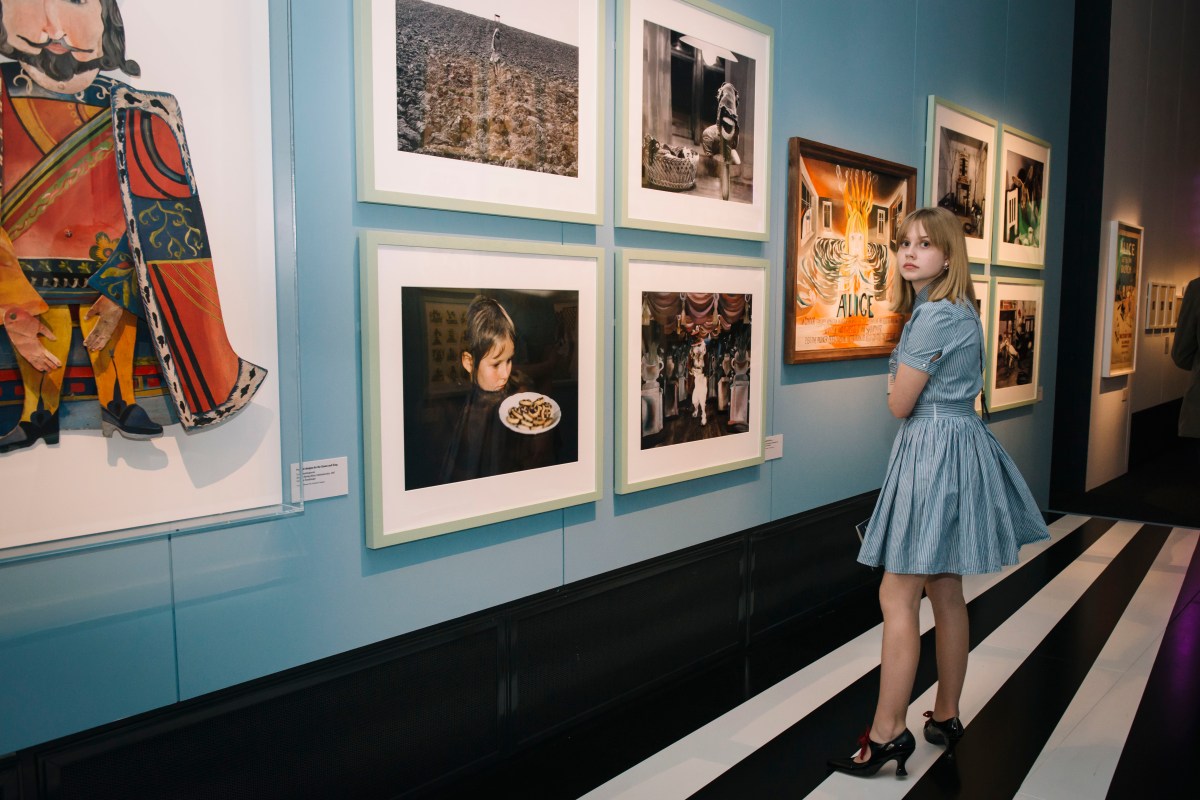Developed by the Australian Centre for the Moving Image (ACMI), Wonderland combines an impressive collection of Alice memorabilia with a mindblowing selection of high-tech magic to create this enchanting adventure down the rabbit hole. ACMI’s largest project to date, Wonderland was created over the span of three years, and contains more than 300 original objects.
Charles Lutwidge Dodgson published Alice’s Adventures In Wonderland under his pseudonym, Lewis Carroll, in 1865. By 1886 it had become a West End musical and shortly afterwards artists began to experiment with painting Alice scenes on glass slides, to be used with an early form of projector called a Magic Lantern. The first cinematic adaptation was released in 1903, followed by an Alice movie with sound in 1931. Since then, countless adaptations, beloved by multiple generations, have been made across all forms of media.
The ACMI exhibition begins in Carroll’s recreated drawing room, an authentically designed space rich in Wonderland history. Carrollian curiosities include 1880s editions of the author’s puzzle books, and examples of his photography. Carroll’s Assisted self portrait series includes a side-profile that shows him looking down at papers on his desk (1874), reading a book (1857) and sitting on a windowsill (1856).
Just as attendees are beginning to feel at home in the drawing room, they reach The Lost Map of Wonderland, which comes to life by interacting with a series of custom plinths. There are different maps available for different age groups, each with its own set of clues, facts and potential animations. Fittingly, the remainder of Wonderland can be accessed from Carroll’s drawing room by crawling through a tiny door (for those with brave kneecaps) or by walking through a normal-sized door (for everyone else).
The Hallway of Doors has a black and white floor that leads to a mirrored wall, creating the illusion of a much larger room – an excellent example of how Wonderland plays with scale. Within this hallway is a tall table with a glass face, upon which a gold key is placed – just out of reach – allowing attendees to experience first-hand why Alice finds six inches to be ‘such a wretched height’.
The Hallway of Doors leads to a variety of themed rooms, each heavy with their own curious magic. One of these rooms contains a selection of Sir John Tenniel’s original illustrations, dating as far back as 1865. Another room contains a miniature silent film theatre. It is easy to become disoriented while exploring these spaces, in which one can see a variety of artefacts, ranging from secret drawers to Carroll’s own photographs of Alice Liddell, upon whom the titular character was based.
The Queen’s Croquet Ground combines analogue and digital media in a captivating craft activity. Participants sit at tables made of giant playing cards, where they are given prints of the aforementioned Tenniel illustrations. After creating a Wonderland collage, participants insert their completed creations into a contraption, and stick their faces into a hole to be photographed. Within seconds, a humanoid playing card appears on a wall-length depiction of the Queen’s croquet ground, wearing both the face and creation in question. Mosster Studios collaborated with ACMI to make The Queen’s Croquet Ground a place to encourage fun, creativity and personal engagement.
An entire section of Wonderland is dedicated to the 1951 Disney film, Alice in Wonderland, complete with story sketches, clean-up animation drawings, live action reference photos, cel setups, concept art and international film posters. Another space is dedicated to Tim Burton’s 2010 adaptation, with concept art, production stills, and Tim Burton’s own character sketches for the Red Queen and Cheshire Cat.
Other exciting oddities of the exhibition include wall-sized illustrations from early editions of Alice’s Adventures in Wonderland, and a tall narrow building giving non-claustrophobic patrons a chance to squeeze themselves into the White Rabbit’s house.
The Pool of Tears contains a range of Magic Lantern slides. Movie memorabilia including cheerful vintage film posters, magical mirrors and costumes from the 1980s are displayed alongside taxidermied scene designs and grotesque sculptures from darker adaptations. A semi-circle of 18 screens plays a tribute to all things Alice, spanning movies, video games, music videos, anime, cartoons, commercials and more. A variety of secret drawers are hidden throughout, with snippets of iconic film history hidden within.
One of the many highlights of this exhibition has to be A Mad Tea Party, which is a self-contained installation of technological prowess and artistic wonder. Attendees are invited inside a hidden room, containing a table set for a tea party. The walls are bare and the plates are all empty, until everyone sits down. Then, music plays. Illuminated words appear from nowhere, quoting lines from Carroll’s original text. Letters explode into thousands of lights, which rearrange themselves to form surreal Wonderland landscapes.

The trajectory of visual progression mimics the digital design process, beginning with wire frames before progressing to rendered images, accompanied by a hypnotic original soundscape. Tablecloths, napkins, cakes, jellies and lines of marching ants appear as if by magic. Butterflies land on macarons, plates spin of their own accord, and the March Hare’s head appears with a directive to: ‘have some wine’. The forest falls away to reveal an increasingly bizarre land of wonder, boasting gigantic teapots, keys and cups, courtesy of mind-blowing projection mapping techniques by digital studio, Grumpy Sailor. This particular tea party is the closest (most of us) are likely to get to witnessing actual magic.
An additional weekend experience on offer at Boola Bardip is a real-life Mad Hatter’s Tea Party. During this exclusive experience, you can see what you eat, and eat what you see, at the Mad Hatter’s rose-covered table ‘made for a great many more than three’. Beneath a hanging chandelier, on one of many mismatched chairs, you can enjoy colourful ‘eat me’ biscuits, and drink from a glass labelled ‘drink me’. Gourmet sandwich checkerboards, a herb frittata, teacup-themed macarons and red velvet cupcakes complement the seemingly infinite servings of tea, coffee and sparkling on offer. The Mad Hatter’s Tea Party experience is a unique – and unforgettable – add-on, with a price that includes a curated tour of the Wonderland exhibition.
Read: Opera review: A Christmas Carol
Wonderland gets curiouser and curiouser the more time one spends examining it. At least half a day of exploration is necessary, but longer would be preferable. This impressive exhibition succeeds in revealing the history of Alice and the magic of Wonderland by uniquely immersive means, inserting its audience into a veritable Wonderland of literary, artistic, theatrical, cinematic and pop-cultural history.
Alice in Wonderland
WA Museum, Boola Bardip, WA
Conceived by: Jessica Bram, Chris Harris and Sarah Tutton, ACMI
Curated by: Jessica Bram and Sarah Tutton, ACMI
Exhibition and concept design: Anna Tregloan
Interactive design: Sandpit, Mosster Studios, Grumpy Sailor
Set design: Onset Arts
Sound design: Byron Scullin
Composition: Cornel Wilczek
Lighting design: Niklas Pajanti
Motion graphics design: Field Carr
Director of exhibitions and touring: Chris Harris
Head of touring: Anat Meiri
Exhibition technician: Michael Alonso
Exhibition technician: Steve Walsh
Registrar, touring: Angela Petrow
Tickets: Free – $80
Alice in Wonderland will be on display until 23 April 2023.





